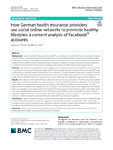2021-02-18Zeitschriftenartikel
How German health insurance providers use social online networks to promote healthy lifestyles: a content analysis of Facebook® accounts
Loss, Julika
von Uslar, Charlotte
Background
Social networking sites such as Facebook® can contribute to health promotion and behaviour change activities, but are currently underused for this purpose. In Germany, health insurance companies are relevant public health agencies that are responsible for health promotion, primary prevention, and health education. We intended to analyse the Facebook® accounts of health insurance providers to explore the range of prevention topics addressed, identify the communication formats used, and analyse user activity stimulated by prevention-related posts.
Methods
We performed a quantitative content analysis of text and picture data on Facebook® accounts (9 months in retrospect) in a cross-sectional study design. 64/159 German health insurance providers hosted a Facebook® page, 25/64 posted ≥ 10 posts/months. Among those 25, we selected 17 health insurance companies (12 public, 5 private) for analysis. All posts were categorized according to domains in the classification system that was developed for this study, and the number of likes and comments was counted. The data were analysed using descriptive statistics.
Results
We collected 3,763 Facebook® posts, 32% of which had a focus on prevention. The frequency of prevention-related posts varied among health insurance providers (1–25 per month). The behaviours addressed most frequently were healthy nutrition, physical activity, and stress/anxiety relief, often in combination with each other. All these topics yielded a moderate user engagement (30–120 likes, 2–10 comments per post). User engagement was highest when a competition or quiz were posted (11% of posts). The predominant communication pattern was health education, often supplemented by photos or links, or information about offline events (e.g. a public run). Some providers regularly engaged in two-side communication with users, inviting tips, stories or recipes, or responding to individual comments. Still, the interactive potential offered by Facebook® was only partly exploited.
Conclusions
Those few health insurace companies that regularly post content about prevention or healthy lifestyles on their Facebook® accounts comply with suggestions given for social media communication. Still, many health insurance providers fail to actively interact with wider audiences. Whether health communication on Facebook® can actually increase health literacy and lead to behaviour changes still needs to be evaluated.
Dateien zu dieser Publikation

